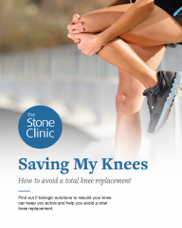Posterolateral corner rehab protocol
- Full weightbearing as tolerated with hinged brace locked in full extension for 4 weeks.
- Patient will be instructed to come out of the brace twice a day for gentle, passive stretching into flexion. Avoid active knee flexion for 4 weeks.
- Regular assessment of gait to watch for compensatory patterns. Watch especially to avoid posterior-lateral knee thrust in stance phase of gait.
- Regular manual treatment to soft tissue and incisions to decrease the incidence of fibrosis.
- Avoid direct palpation to surgical portals x4 weeks, “no touch zone” 2 inches from portals. Refer to wound care protocol for full details.
- No resisted leg extension machines (isotonic or isokinetic) at any point in the rehab process.
- No high impact or cutting/twisting activities for at least 3 - 4 months post-op.
- MD/nurse follow-up visits at Day 2, Day 14, 1 month, 4 months, 6 months, and 1 year post-op.
Week 1
- Nurse visit Day 2 to change dressing and review home program. Icing and elevation regularly.
Manual
- Soft tissue mobilization to quadriceps, posterior musculature, suprapatellar pouch, popliteal fossa, iliotibial band, Hoffa’s fat pads.
Exercises
- Straight leg raise exercises (lying, seated, and standing), quadriceps/adduction/gluteal sets/abduction exercises.
- Hip and foot/ankle exercises, well-leg stationary cycling, upper body conditioning.
- No active range of motion knee flexion x 4 weeks
Goals
- Passive range of motion knee flexion <70 degrees Passive knee extension 0 degrees
Gait
- Full weight bearing with brace locked in full extension
Weeks 2 - 4
- Nurse visit at 14 days for suture removal and check-up.
Manual
- Manual resisted (i.e. PNF patterns) of the foot, ankle, and hip.
- Continue with pain control, range of motion, soft tissue treatments, and proprioception exercises.
Exercises
- Non-weightbearing aerobic exercises (i.e. unilateral cycling, upper body ergometer, Schwinn Air-Dyne non-involved limb and arms only).
- Trunk and gluteal stabilization program.
- No active range of motion knee flexion x 4 weeks
Goals
- Passive range of motion 0 to 90 degrees
Gait
- full weight bearing with brace locked in full extension
Weeks 4 - 6
- MD visit at 4 weeks post-op; will wean off use of rehab brace. Brace range of motion can be set at open during wean off process.
Manual
- Manual treatments to work on full range of motion flexion and extension, initiate scar mobilization once portals completely closed.
Exercises
- Stretches for full range of motion.
- Incorporate functional exercises (i.e. knee bends/squats, calf raises, step-ups, proprioception).
- Stationary bike and progressing to road cycling as tolerated.
- Slow walking on treadmill for gait (preferably a low-impact treadmill).
- Pool/deep water workouts (once incisions are healed).
Goals
- Initiate active range of motion knee flexion.
Gait
- Unlock brace, slow transition to wean off brace.
Weeks 6 - 8
- Increase the intensity of functional exercises (i.e. cautiously increase depth of closed-chain exercises, Shuttle/leg press). Do not overload closed- or open-chain exercises.
- Add lateral training exercises (i.e. side-step-ups, lateral stepping) once adequate mechanics are achieved.
Goals
- Patients should be progressing to walking without a limp.
- Range of motion should be at least 80%
Weeks 8 - 12
- Introduce more progressive single-leg exercise (i.e.Theraband leg press, single-leg calf raises).
- Careful analysis of gait and mechanics with corrective treatment (i.e. orthotics, gluteal strengthening).
- Patients should be pursuing a home program with emphasis on sport/activity-specific training.
Weeks 12 - 16
- Low-impact activities until able to demonstrate adequate completion of a functional/sport test.
- Increasing intensity of strength, power, and functional training for gradual return to activities.
NOTE: All progressions are approximations and should be used as a guideline only. Progression will be based on individual patient presentation, which is assessed throughout the treatment process.

